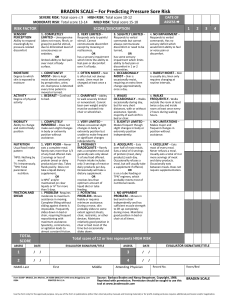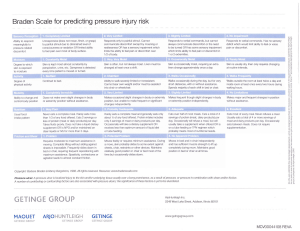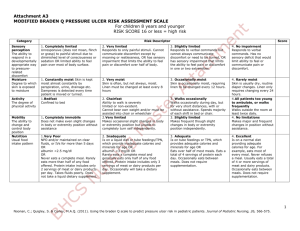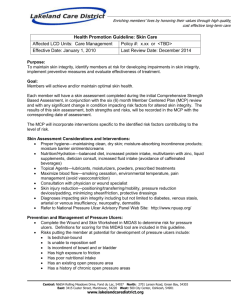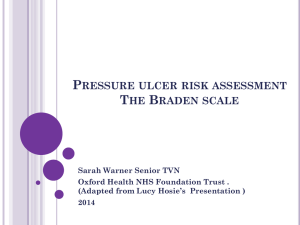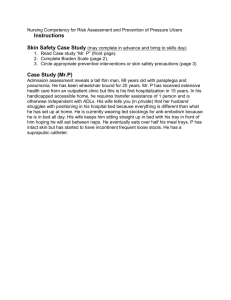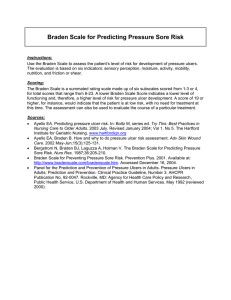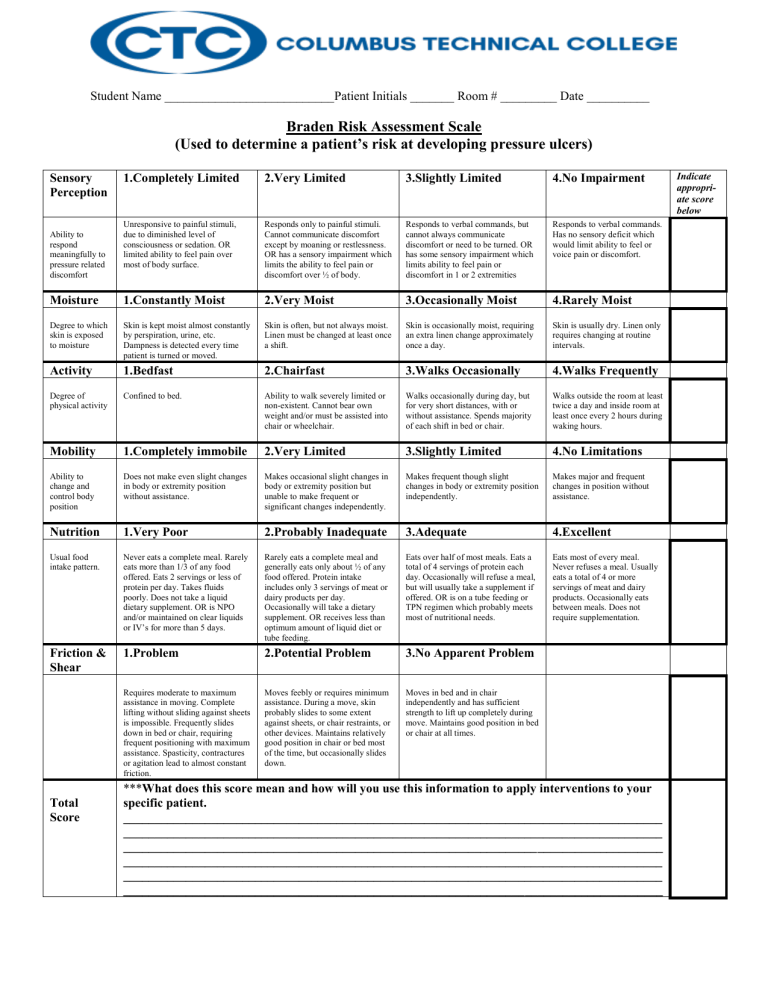
Student Name ___________________________Patient Initials _______ Room # _________ Date __________ Braden Risk Assessment Scale (Used to determine a patient’s risk at developing pressure ulcers) Sensory Perception 1.Completely Limited 2.Very Limited 3.Slightly Limited 4.No Impairment Unresponsive to painful stimuli, due to diminished level of consciousness or sedation. OR limited ability to feel pain over most of body surface. Responds only to painful stimuli. Cannot communicate discomfort except by moaning or restlessness. OR has a sensory impairment which limits the ability to feel pain or discomfort over ½ of body. Responds to verbal commands, but cannot always communicate discomfort or need to be turned. OR has some sensory impairment which limits ability to feel pain or discomfort in 1 or 2 extremities Responds to verbal commands. Has no sensory deficit which would limit ability to feel or voice pain or discomfort. Moisture 1.Constantly Moist 2.Very Moist 3.Occasionally Moist 4.Rarely Moist Degree to which skin is exposed to moisture Skin is kept moist almost constantly by perspiration, urine, etc. Dampness is detected every time patient is turned or moved. Skin is often, but not always moist. Linen must be changed at least once a shift. Skin is occasionally moist, requiring an extra linen change approximately once a day. Skin is usually dry. Linen only requires changing at routine intervals. Activity 1.Bedfast 2.Chairfast 3.Walks Occasionally 4.Walks Frequently Degree of physical activity Confined to bed. Ability to walk severely limited or non-existent. Cannot bear own weight and/or must be assisted into chair or wheelchair. Walks occasionally during day, but for very short distances, with or without assistance. Spends majority of each shift in bed or chair. Walks outside the room at least twice a day and inside room at least once every 2 hours during waking hours. Mobility 1.Completely immobile 2.Very Limited 3.Slightly Limited 4.No Limitations Ability to change and control body position Does not make even slight changes in body or extremity position without assistance. Makes occasional slight changes in body or extremity position but unable to make frequent or significant changes independently. Makes frequent though slight changes in body or extremity position independently. Makes major and frequent changes in position without assistance. Nutrition 1.Very Poor 2.Probably Inadequate 3.Adequate 4.Excellent Usual food intake pattern. Never eats a complete meal. Rarely eats more than 1/3 of any food offered. Eats 2 servings or less of protein per day. Takes fluids poorly. Does not take a liquid dietary supplement. OR is NPO and/or maintained on clear liquids or IV’s for more than 5 days. Rarely eats a complete meal and generally eats only about ½ of any food offered. Protein intake includes only 3 servings of meat or dairy products per day. Occasionally will take a dietary supplement. OR receives less than optimum amount of liquid diet or tube feeding. Eats over half of most meals. Eats a total of 4 servings of protein each day. Occasionally will refuse a meal, but will usually take a supplement if offered. OR is on a tube feeding or TPN regimen which probably meets most of nutritional needs. Eats most of every meal. Never refuses a meal. Usually eats a total of 4 or more servings of meat and dairy products. Occasionally eats between meals. Does not require supplementation. Friction & Shear 1.Problem 2.Potential Problem 3.No Apparent Problem Requires moderate to maximum assistance in moving. Complete lifting without sliding against sheets is impossible. Frequently slides down in bed or chair, requiring frequent positioning with maximum assistance. Spasticity, contractures or agitation lead to almost constant friction. Moves feebly or requires minimum assistance. During a move, skin probably slides to some extent against sheets, or chair restraints, or other devices. Maintains relatively good position in chair or bed most of the time, but occasionally slides down. Moves in bed and in chair independently and has sufficient strength to lift up completely during move. Maintains good position in bed or chair at all times. Ability to respond meaningfully to pressure related discomfort Total Score ***What does this score mean and how will you use this information to apply interventions to your specific patient. ______________________________________________________________________________________ ______________________________________________________________________________________ ______________________________________________________________________________________ ______________________________________________________________________________________ ______________________________________________________________________________________ ______________________________________________________________________________________ Indicate appropriate score below

